#Mamacona
Explore tagged Tumblr posts
Text
Inca Maiden
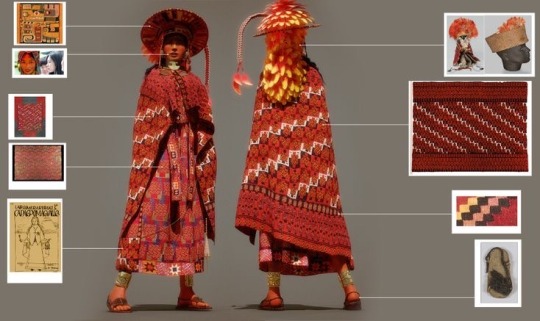
The clothes shown here correspond to the Chuquibamba style, an allied kingdom of the Inca empire

The acllas in the Tahuantinsuyu*, were the women of greater cultural preparation. These women were recruited and then chosen to be prepared in the so-called Acllahuasis, which were in charge of the Mamaconas, as stated by the chronicler Bernabé Cobo:
"... the acllahuasi or house of chosen women was an institution that brought together the Mamaconas or Ladies Mothers who acted as teachers and a credible number of girls entering a closing regime between the ages of ten and twelve. They were collected as a tribute among the most noble and beautiful ... "
Source
*Empire of four (the Inca empire)
#incan#inca#inca culture#incas#Inca Maiden#Maiden#Acclahuasi#Mamacona#tahuantinsuyu#Chuquibamba#incan art#pre columbian#peru#inca empire#ladie mothers#ancient history#ancient america#priestess#royality#noble woman#aclla#acllas
20 notes
·
View notes
Text
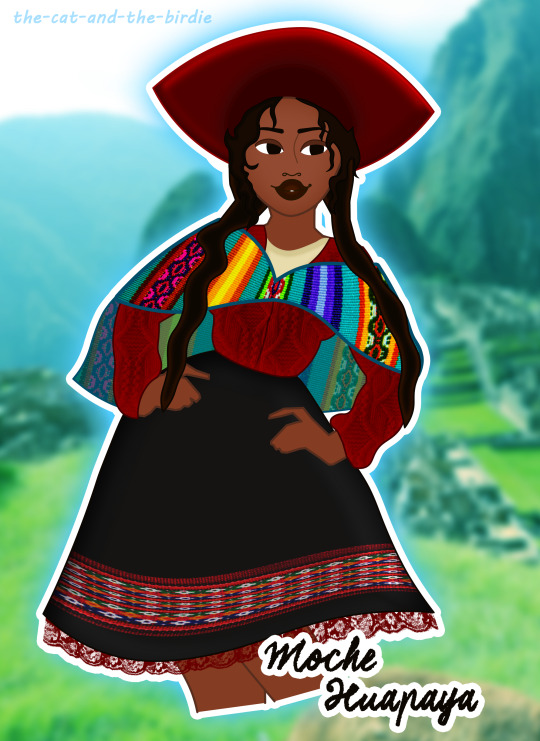

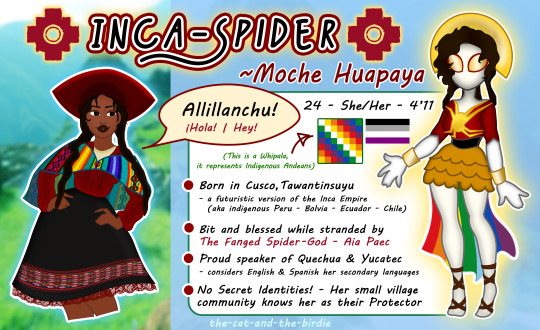

Inca-Spider - Moche Huapaya - Earth-802
Pronounced 'Mo-Chae HWA-Pa-ya' (Also goes by Mochi) - 24 - She/Her - 4'11 - Yes, I ship her with Miguel. - From Incan Year 802 (or our 1992) ______________________________________________
Bitten and blessed by The Fanged Spider-God - Aia Paec, Moche is the wall-crawling protector of Cusco. Along with the likes of Pavitr and Spider-man Noir, she's a part of a small class of Spider-people blessed and empowered of Gods.
Moche Huapaya:
Moche is best described as warm and independent. She's autistic, and spent most of her childhood weaving alone, or roaming the mountainous plains around her village with her family's pack of llamas. But Moche loves people, and has always found much community in her village's temples, her Aunt Mayu a great curandera (healer). Moche takes after her aunt, always eager to help. And she was raised by her aunt and Uncle Huacan to always serve the community, but always find strength within herself. Advice that'd become very useful the night her village was attacked. At 15, after centuries of peace, the Spanish army invaded her country, armed with new vibranium-made weaponry. Chased into the wilderness by Spanish soldiers, and stranded - Moche unknowingly came across Huachuma* [Hwa-chu-ma], a sacred psychedelic cactus, and ate it to avoid starvation. As she began to consume the plant, a spider crawled from the root and bit her - And as she fell under a spell of Huachuma and venom, she was faced with Aia Paec, The Fanged Spider-God. She returned to her village as The Inca-Spider, the Avatar and vessel of Aia Paec. And she has the fangs to prove it. For 9 years, Inca-Spider has served as the nation's protector, defending them through the intensive and ongoing war with the Spanish. The summer after her college graduation, Moche returned from Lima to her family home Cusco. The day before returning to the city, Moche's village is faced with a strange man - almost 7 foot tall, and speaking Spanish. And to her, Miguel is the strangest person she's ever met. But above all else - Moche's still just a 24 year old in 1992 and she acts like it. Sarcastic but lighthearted, she likes Quechuan soap operas, Q-Pop (Quechua Pop), riding her motorcycle and surfing off the coast of Lima.
The Inca-Spider:
The Provider of Water and Protection - Aia Paec has protected the Quechua people for centuries. Considered the Decapitator, his fanged mask sits in every Inti temple. Victorious against the first Spanish invasion, Aia Paec fell dormant - relegated to a bringer of rain. And so did the Inca-Spider. But when there is a need, Aia Paec is of service. Compassionate but not merciful, Aia Paec submits to no one - but his community. And he considers all Quechua people as his children. The newest living incarnation - Moche is no different. She's the village Curandera (a indigenous healer), responsible for spiritual brews, divination, and ceremony - a tradition taught to her by Aunt Mayu. After her aunt's passing, she also went on to become a Mamacona (Sun-god Inti's temple attendant) As a Mamacona she now lives at the Inti temple with the other 'nuns', and despite her loss, she considers her sisters as her found family. And they ALL have an opinion on Miguel. (They call him AncaApu or 'Blue Mountain' for how tall he is.)
[WARNING: This post is LONG. VERY LONG. Like..my longest so far. And very detailed. Below are more details about Moche's Style & Design, Origin, Powers, & Other Quechua cultural details.
Plus her relationship with Miguel, her role in ATSV and her friendship with Hobie. [There are mentions of colonization in this post - as well as how joining the Society and learning about Spanish colonization affected her. * - There are also mentions of the ceremonial psychedelic Huachuma Cactus, which is a real and practiced Andean ceremony to this day. I personally have sat in ceremony and would love to share my experience/knowledge - for more information on these medicines - check the very bottom. Thanks!]
Style:
When Moche is in her home city of Cusco, she will often wear the traditional Quechuan style of dress - a red sweater, a black and decorated skirt, and a wide brim hat. One of the only remnants of the Spanish's attempt at colonization - Quechuans in Tawanti instead see their dress as something completely reclaimed, a reflection of their resilience and art.

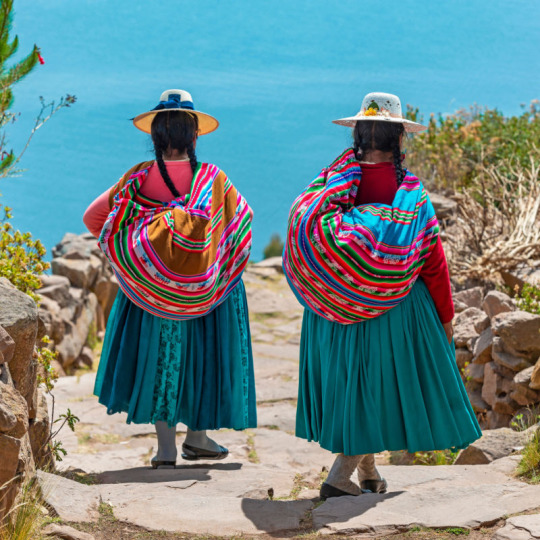

And because she spends most of her time between there and Spider Society - it's almost everyday that you can find Moche in a petticoat and red sweater, made from the wool of village's llamas. She's worn a hat and black skirt from childhood to college, and when she's back home, she has no plans of stopping. Because of this Moche prefers skirts, and never wears pants if she can help it. Thought that became a problem walking upside down at HQ. So now she sews her own harem pants with tiered lace around them, to give the same fluffy illusion. But when it comes to skirts, she likes them any length, any fluffiness. Even black jean skirts. She's from 1992 after all. However while on HQ, Moche likes to wear her hair out of her braids, knowing the older women at the Inti Temple would have a heart attack over it. As gold is sacred to her people, it's VERY fashionable back home, and Moche tries to wear it as much as she can. Just the same, when not in her everyday-Quechua clothing, she'll usually be caught wearing a red-top/black-skirt combo and a hat of some sort. She feels naked without them or a little gold.
Her Suit:
Not being able to wear a skirt while swinging was one of the main thoughts Moche kept in her mind during the designing process, and the solution - lace bloomers and a waist-cape! But unlike most Spider-people, Moche didn't make her suit at all. Aia did. Much like Miguel's, Moche's suit is a layer that manifests over her body when her web-gauntlets are on. Aia Paec manifested the suit based on what he perceived to be Moche's needs and tastes. The foot straps were her idea though. Moche's head-dress is directly inspired by the traditional headdress of Warrior Priests - When Moche hangs upside down, her headdress and cape forms her home flag. And although Moche is ace - that's not a LGBTQ+ flag! It's the actual Flag of Cusco, Peru -

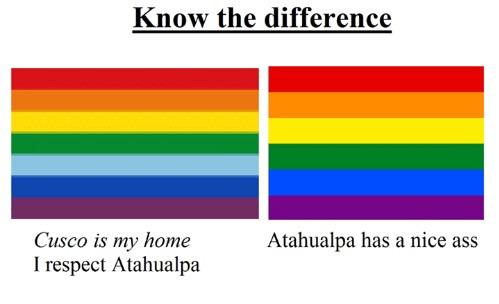
[Sometimes the Cusco flag is also shown without the gold emblem! And the original (Gilbert Baker) pride flag has extra colors - so how do you tell them apart? LGBTQ+ flags usually have an even number of stripes. Cusco is always odd. Good rule of thumb: LGBTQ+ = queer, but Cusco = odd.] Though she gets questions about it on campus A LOT. Moche also grew up wearing sandals all the time, so running around in her suit barefoot felt a little wrong to her. Instead she ties leather straps at her ankles - to help her grip when clinging to mountainsides or cliff faces.
Face Claim(s): Quechua-rapper Renata Flores

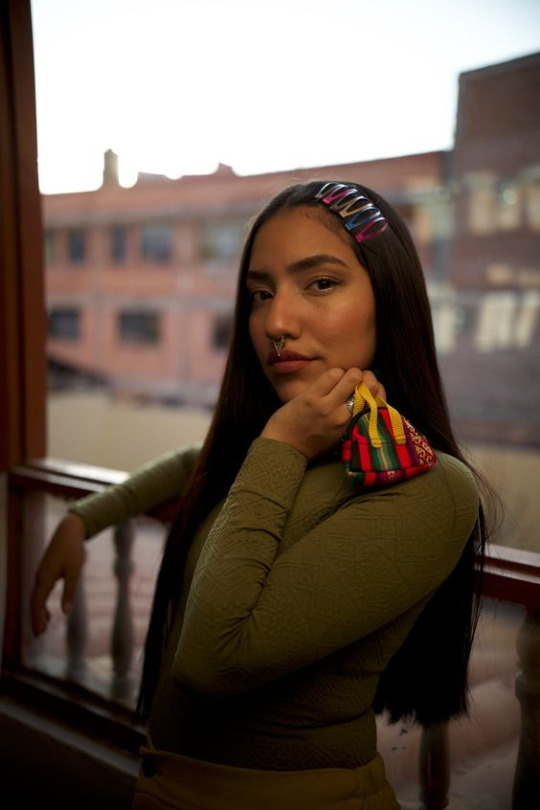
History & Origin:
Living in the Andean year 802 (1992 for us), Moche was raised in the mountains outside of Cusco, a historical, bustling city teeming with Inca culture and religion. Tawantinsuyu (the indigenous name for Peru, Chile, Boliva, Ecuador etc) - or just Tawanti has known peace for 400 years. But when Moche is 15, her village is attacked, thrown into chaos as the Spanish unleash another war, backed with new vibranium weaponry. Moche's Auntie Mayu urged her to flee to the mountains, taking her families herd of llamas with her. Chased into the wilderness by Spanish soldiers, Moche - once a clever navigator - found herself disoriented and stranded among the deserted hills and plains. Facing starvation, Moche collapsed at the foot of a Huachuma Cactus - unknowing of the sacred plant teacher inside. Begging for mercy and to live, Moche ate the cactus to survive - unknowing of the plant's ceremonial and psychedelic nature - or the spider inside. Moche was faced with 'Aia Paec - The Decapitator' - a fanged spider-god in her religion. The protector of The Inca, Aia Paec presented Moche with her first premonition: the potential destruction of her people. Aia then presented Moche with a choice: become the Avatar of the Spider-God - or refuse, having no recollection of the event afterwards. Either way, she'd live another day. Moche accepted the role of Avatar, earning her fangs and web gauntlets. And she returned to her village as the Inca-Spider. Although her Uncle Huacan died in the fight, Moche arrived in time to fend off the first of many Spanish attacks. With fangs of her own to prove her title of Avatar, she was accepted by her community with open arms, her identity as Inca-Spider open and known. However, they do not revere her, instead seeing Moche more as a public servant than an idol. Moche lived in her village outside of historic and sacred Cusco until she was 18, before attending college in the futuristic city of Lima - near the pacific coast. - During the 16 century, a mine of gold near the city was found laced with Vibranium, catapulting the nation into a Wakanda-like surge of advancement. There Moche attended the University of Lima on a musical scholarship, for her cultural flute playing. At 24, she graduated Cum Laude with a dual degree in Cultural Studies and Computer Science (she's technically still from 1992). During this time, she learned English and Spanish. [However she does not speak Spanish natively at all, and speaks it like any other person who learned it in college. Considering this, the history of her nation, and confusion around Spanish gendered nouns (as Quechua has none) she prefers to speak English]
Powers and Abilities:
Moche has all the usual Spider-Powers - including a pair of fangs to prove her title of avatar. However, unlike Miguel, Moche's are purely ornamental, and she'll only really flash them to other Quechua people to prove her status. They're unretractable and noticeably shorter than his.


The niece of a textile weaver, Moche is a Weaver spider - like Pavitr, she focuses on maneuvers and flips that allow her to create webs and tangles. Her web-shooters easily cocoon opponents, and Moche often uses webs as wings and gliders instead of swinging, which is more convenient in the Andean mountains. Up-keep: To maintain her abilities, Moche must follow a thorough moral code and spiritual regimen - including things such as divination, meditation, formal ceremony, and occasionally fasting. One time throughout the year, Moche loses her powers. During this time she enters a period of isolation, fasting, meditation, and spiritual rest. All the while, she can only access her powers if she or her community is in direct danger, in which she has to call upon Aia. Otherwise, during this time she reverts to an average human, and focuses on self-reflection, devotion, and mindfulness. Once she's recharged and proves to Aia her duty to her great responsibility, she regains her great powers. This cycle usually takes 3 weeks out of the year. Web-shooters: Moche's Web-shooters are not mechanical or organic, but something in between. The second mark of the Avatar is her gauntlets, two relics given to her by Aia Paec. They're magical, spawning unlimited golden webs. However, they act like organic webs - because they spawn whenever she needs them. Moche's gauntlets can't be stolen or lost. When legitimate danger strikes, her cuffs will appear within her reach or bag immediately. Once they are on, however, they can't be taken off until the threat is dealt with or gone. Aia Paec sees fleeing as dishonorable, and so for Moche it's not an option. The Machu Blade: A real-life blade found at Machu Pichu, Moche weilds a golden ceremonial blade used like the one below. Used to farm Huachuma in Tawanti, she mainly uses it for farm work. The blade spawning from her gauntlet, Moche often uses it like a machete in battle - but the white of her suit will never stain with blood and the blade itself cannot pierce her. She usually combines it with her webs, throwing it over her head or swinging it at opponents before lassoing it back. Ever seen the use of the tomahawk in the movie 'Prey'? She's doing that.


[POV: You're dishonorable and with be dealt with swiftly] Eye of the Spider - Every battle is made equal and honorable with this ability. Moche will get visions that help her even the field in battle. She can't see hits coming, but if the enemy is planning on doing something that is considered dishonorable in battle, Moche will get a vision in warning. Example: If Moche gets into a fight she believes is one-on-one, but the person has a third party in hiding to ambush her, Aia will give her a vision in warning. - If instead, the other person discloses the third party before the fight, Aia Paec would consider that an honorable move, and Moche wouldn't get a vision. This extends to things such as concealed weapons, hidden doors/rooms, acts of cheating/slight - and if you're bluffing at Poker, she can see your cards. She can't help it, and it's technically NOT cheating. According to her. Aia took some convincing. Still that trick got her through college. Intentional lies always go noticed by her as well. The Big Guy Upstairs Aia Paec is considered both a provider and warrior for the Andean people. Ruthless in battle, Aia Paec is the creator god responsible for all food, water, and triumph in war. He is about balance, honor, and respect above of things. Fortunately for Moche, he's more agreeable than say - Venom or Khonsu - and he doesn't care much for Moche's personal life or interests. Sure, he cares about her well-being. But not her soap-ops. However when it comes to The Inca-Spider, Aia Paec can be demanding, and he'll never let Moche walk away from a 'worthy' or justified battle. He cares little about things like pride, but if he feels like someones basic respect or rights are being encroached on, or someone is being threatened by another stronger than them, he WILL make Moche step in. Either by pestering her, or if necessary, assuming control and getting her into a fight before leaving Moche to get out of it. ('That wasn't me, I swear. God made me smack you.') After witnessing Miguel attack Miles and assault both Gwen and Diane (while sending Gwen home), Aia Paec declares Miguel as dishonorable and compels Moche to battle him. Despite her deep care for Miguel, Moche chose to follow her oath to Aia Paec and oblige.
Moche & The Spider Society: And the trauma of joining -
Recruitment:
The summer after her graduation, Moche returned home to her family home Cusco. The day before returning to the city, Moche's village is faced with a strange man - almost 7 foot tall, and speaking Spanish. Moche is immediately skeptical and very suspicious of the man named Miguel - and she almost doesn't believe his story, concerned he may be a Spanish spy. That is, until she realizes that he's marked with fangs, the same way she is. Still, he has to earn her trust. And getting her to join is no easy feat. First, she must test his honor. The test took three days, a trek to the mountains and a meeting with Huachuma cactus and Ayahuasca brew that changed Miguel's life. Miguel passed Aia Paec's test in the Astral Plain, and so - as she'd promised - Moche joined the Spider Society, with him as her mentor.
"Integration":
To be honest, Moche's first few weeks on campus could be considered outright traumatic. However, it wasn't the Society or technology she found jarring - but the loss of her culture. During her induction process, it had been Miguel's job to tell her about the colonization of her people - in almost all other universes. Until this point, Moche had no understanding of Latin America, because to her - America had never become latin. Up until this point, she had only a vague idea of why Miguel spoke Spanish and not Yucatec, but it was only then that she was explained the full extent of the damage. Quechua culture, people, and language are still VERY much alive today, with 8 million native speakers (it's actually the indigenous language in the Americas with the most speakers) - but that does not understate the massive destruction and slaughter they endured at the hands of the Spanish - even down to the murder of their last emperor - nearly 600 years before 2099. In the multiverse, much of the culture and history Moche has been taught over her lifetime doesn't exist - the massive developments made in the last half century completely lost. To her, the country of Peru was foreign, despite her being 'from there'. It was a very sharp shock to the senses, and Moche went through a deep period of mourning. Even moreso, she became terrified of collapsing her universe - and the only trace of her culture. Induction periods are usually spent in the dorms, and Moche spent most of her time there alone. During that time she between talking to the Lyla in her watch, and the two became close friends. To Miguel this hardship was completely unexpected - and unintentional. A majority of his time went to rectifying this and trying to comfort Moche. Determined to avoid the trauma towards recruits in the future, Moche and Miguel directly developed The Spider Society Adjustment Course together (- in which vulnerable recruits live in a separate wing and receive services like therapy and a mix of mental health and multiversal culture courses) It took Moche a long while to adjust - and she still is, mostly working at Society HQs in administrative roles rather than active missions. Those she is great in the field. But she still has a LOT of problems with people constantly misrepresenting her because of her indigenous ancestry and unique universe. "Oh! A Peruvian Spider! We love a latina queen!" "No. I'm not Latin." "Sorry, 'Hispanic', then?" "No, I learned Spanish in college." "So, then what are you? Not to be rude." "Inca." "Those still exist?? Or are you from like 1500 or something like Webslinger? OMG Are you from El Dorado or something?" "El Dorado is Spanish. Also, it doesn't exist. Also no. I'm from 1992." "That doesn't make much sense cause the Spanish-" *Moche looking at a nearby Lyla like she's on The Office*


['There's a talking piece of fucking plastic and a sentient car here what is so mystical about an indigenous person to these people???????'] -Moche ranting to Lyla later
Moche & Her Job @ The Society:
Overall, Moche is clearheaded but a total 'Type A' personality. She loves to stay busy, consistently the only person on campus who gets up before Miguel. She is known as a 'Class A - Weaver' Spider under Society Specifications, and is usually called for missions that include large crowds of civilians - as she's great at making cocoons and hammocks to catch people. Recruited and mentored by Miguel, she's a graduate of the Spider Society Educational Program - with a concentration in a Multiversal Sociology and Data Input - basically learning and tracking the cultures of the incoming recruits. After revolutionizing the Societies' computer systems with a computerized version of Quechua Quipus (an ancient information system made of strings), Moche was promoted to Third-in-command, after Miguel and Jessica.
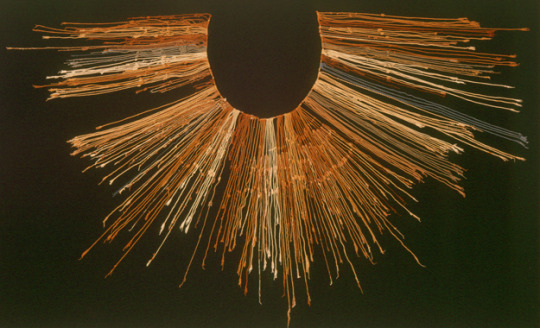
[A Quipu for reference. Imagine the base canon event of being bit as the central string, and all other canon events/canonical paths being the outward strings. She did that but in Lyla if that makes sense.]
She also works as Miguel's '2nd assistant' - the person who does all the things Lyla can't. Like getting Miguel coffee. Or making sure he eats, reminding him to drink water. Fetching parts and physical files for him, and reminding him the details of every recruit before a meeting. If something is going down on campus - If it involves talking to people, It's her Miguel's sending.
Moche & Miguel:
Yes. I ship them. (Also I'll write more in another post but)
Moche and Miguel aren't necessarily boyfriend and girlfriend. If you ask, they'll say they're 'seeing one another'. And then they'll quickly change the conversation because talking about relationships in the workplace in unprofessional and they're professionals (and shy).
In fact, their relationship could even be described as Non-conventional because they're extremely conventional.
As in, Moche and Miguel operate like a pair of 1950's teenagers that are 'going steady'. If anything, their relationship is a lot closer to 'courting' than dating. Whereas Diane and Hobie hardly ever go on dates, Miguel and Moche go on dinner dates a LOT. Usually accompanied by flowers and Miguel having to drop her off at the temple after. (He has to bring something gentlemanly or else the older Mamaconas are NOT letting her out). The two of them had to build up to holding hands before they ever kissed - if that gives you a better idea of what I mean. Before she fully joined the society, Miguel was almost embarrassed when he walked in on her and for the first time she wasn't wearing her braids - as if that were an intimate thing to see. He apologized profusely. She apologized profusely, telling him it was okay. Aia Paec was annoyed with the both of them.
When it comes to pet names, neither use Spanish terms. Just cause. The first time he called her 'mi amor' Moche was probably caught off guard a little.
Instead, they may call each other 'Chata', 'Muna', and 'Wayllu' or any other number of shortened Quechua terms. They also usually say I love you in Quechua, which is simply 'Kuyayki.' [Chata -> Chatashka - Lover / Muna -> Munashka - Darling / Wayllu -> Wayllushka - Beloved] Miguel's most common name for her is 'Cuy' or Guinea, which Moche HATES. In Quechua, 'Cuy' means Guinea pig. The Spanish were known for bringing over beef and cattle, and as a result for her, beef is hardly eaten in Tawanti. Instead, eating and raising Guinea Pig is more common (as is common in Peru). Moche was raised eating cuy. Miguel has never eaten it in his life. Considering cuy LOOKS like a fried guinea pig, he can't really take the thought. But back at her village, Moche was raised breeding and taking care of the cuy. Miguel finds them kind of adorable, and what's even more adorable is Moche looking after them. And since she's fairly small compared to him - he calls her Cuy. To many people - on campus - this is cute. To Miguel it's like calling her bunny or mouse. But to the people in her village, and probably the whole country, it's hilarious. To them cuy are not pets - It's like calling your girlfriend a chicken or turkey and expecting it to be romantic. Which he does. Her telling him to stop usually results in him kissing the side of the head (and doing it again). She'll usually call him AncuApu in return.
With Miguel's past loss and Moche's traditional upbringing, the two enjoy taking it slow. Like really slow. And since both of them are A-spec (Moche ace and Miguel demi) their relationship is mostly to completely romantic and emotional.
Moche's only interest in sex is starting a family one day. And Miguel is fine with that. It wasn't something they really talked or thought about. UNTIL Mayday. Having her around campus, has given Moche baby fever. And even if she's not running to jump in bed, she can't stop saying how much she LOVES Mayday's chunky cheeks and little arms and curly hair and- So when Jess got pregnant - It's like, okay - when's the other baby shoe dropping? Jess is like 'We twinning? Just kidding..We twinning though???' Instead they spend their time eating in downtown Lima (they're foodies), watching Quechua soaps (she got him hooked), or organizing things for the Society. Although those sound like old people married couple stuff, they LOVE it. The two of them see each other as rocks in the other's lives, but more than that, the two of them are most focused on feeling each other out, learning each other, and hopefully starting a future together.
[Lol just wait till you get to the ATSV section - PAIN]
Oh - and while Miguel's test Moche met Gabby face to face while the two of them were in Ayahuasca ceremony - and she was able to deliver a message from her to Miguel. But that's a long story.
Schedule:
Moche still lives back home in her village in Tawantinsuyu, taking over a lot of the spiritual and mundane needs of the village. She wakes up at dawn, tending to the llamas and spiritual herbs in the morning before heading to campus. After, she'll spend her 8-10 hours on Society Campus before returning home to bring in the animals and watchover the community during the night. It's usual for the other Mamaconas (temple assistants) to wait for her portal in the yard, and start talking her ear off right away. But by now, it's normalized. So long as she's not late or anything.
Moche & ATSV:
Moche does not join in on the chase - being physically unable to. Aia Paec declares the act as dishonorable, restricting her movement and 'forcing' her to hang back. She instead heads to the control room to aid Margo and update her on the situation.
When the Go-Home Machine began to go 'haywire', her 'Eye of the Spider' ability allows her to see Miles as soon as he steps in the room. However, Moche chooses not to acknowledge him at Aia Paec's order. Aia Paec also restricts her vocal chords at the time, making it impossible for her to rat Miles out - though she wouldn't either way.
Watching as Miguel assaults Gwen - and then Diane, who comes to her defense - Moche is completely shocked. And although she tries to calm him down - Miguel refuses to hear it.
So Aia compelled her, and she agreed. But terrified of fighting Miguel, Moche made the decision to let Aia Paec assume complete control for the first time - total possession. As Miguel ordered the rest of the Society to scour the multiverse - Aia Paec openly challenged him, citing him as no longer honorable and worthy of the fanged title. And although he is in Moche's body, he will not allow Miguel to go unchecked.
However as the fight stretched on, Moche's emotional state - mixed with the fear of seeing Miguel aggressive beyond her understanding - renders her unable to maintain the connection, weakening Aia's efforts. And the fight ends with Miguel almost badly wounding Moche after Aia refuses to relent.
Aia releases Moche just in time, so she can see Miguel's abuse and dishonorable behavior for herself. Terrified, she comes to with Miguel standing over her, and for the first time Moche finds herself frozen in fear - and she begged him not to wound her further.
Finally coming to the weight of his actions, Miguel however, is horrified. But before he can attempt an apology, Aia Paec resumed control, using the chance to escape through a portal.
However, understanding that her watch would be disabled from this point on - instead of her home universe, a wounded Moche finds herself of the bow of a boat she's never seen.
Hobie's boathouse. Moche may not know him, or Diane, or even Gwen that well. But Aia Paec knows she'll be of use to them. So here she is.
RANDOM HEADCANONS about Moche: [We're almost done I PROMISE - not really lol]
When needed her suit can spawn a manta (called a Lliklla in Quechua).

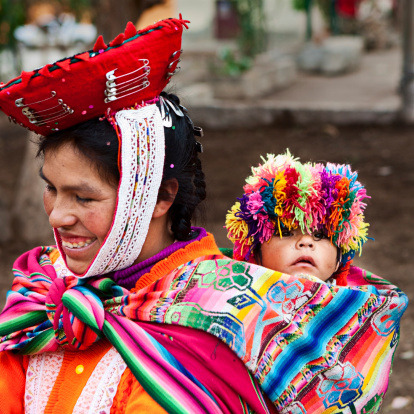
It's a woven cloth worn over the shoulders to carry babies or literally anything else you need to. That's her 'suit purse'.
She will also carry children she rescued in her manta. Or just give them rides around Cusco.
Moche's best friend is Lyla - and she feels a little embarrassed by this. She has to keep telling herself that Lyla is real, she's just not human. Still, kinda weird being from 1992.
But they are very close and have discussed things about if Lyla is real or can feel and stuff - and to Moche it's very clear she can.
Moche is very hard to upset. She's rather calm, and usually expresses sadness more than anger. But for Spider-people that say Lyla isn't real or that she's not sentient -
Moche gets VERY upset very quickly. The both of them find it hurtful and Moche will not talk to you after if you say that. She will immediately leave the room to go be alone.
Being autistic, it can be daunting to make friends though Moche is friendly. She finds talking to Lyla a lot easier, plus Lyla is always in her watch.
Some of the chillest memories Moche has is hanging out with Miguel and Lyla in his office, listening to Spanish music and Q-pop and cracking jokes.
(Miguel can take a joke I promise and he's funny as hell. He tells the jokes that have you like 'damn he got my ass'.)
It usually turns into her and Miguel roasting each other playfully as Lyla keeps score.
Miguel doesn't understand how an AI HE MADE could like Moche MORE.
Because of this, losing access to her watch (and thus Lyla) after ATSV - combined with barely knowing anyone on the houseboat besides maybe Peter, Moche finds herself a bit lonely.
Mentioned by Miguel, Moche became a mentor herself.
She's Pavitr's mentor. When he joined, her and Aia were a large part of redesigning his suit to what it is today.
Since they share a swinging style, she trains him and he's her star pupil.
Pavitr can get really competitive though, and she often has to reel him in when he gets REALLY into it -
Like screaming at the top of his lungs during 4wallFootball or wanting to race people EVERYWHERE.
Pavi is also taller than her. She didn't notice until he brought it up because he's SO PROUD he's found 'someone to be short with'.
She prefers she/her when it's about her specifically - and they/them when referencing IncaSpider, as she considers her and Aia as two people, not one.
Another subtle mark of the Avatar, Moche's eyes glows gold/yellow in the darkness, similar to a cat's - a sign of her Spider-eyes and Aia's presence.
This feature also reduces the amount of glare Moche sees, a very needed thing in the sunny Andes mountains.
Because it can get so sunny and bright during the day, it's hell on earth for Miguel. Sunglasses all day.
But it's the altitude sickness that gets him. He's superhuman but still feels out of breath. And NO amount of chewing coca leaves is enough to help.
So now 4'11 Moche has to baby and look after this nauseous GIANT because she said 'I know a place' then started walking them up a mountain
Moche is a very talented musician and musician - exceptionally so - with a focus on indigenous music
She is a master pan-flute player - and currently one of the only women to reach such status.
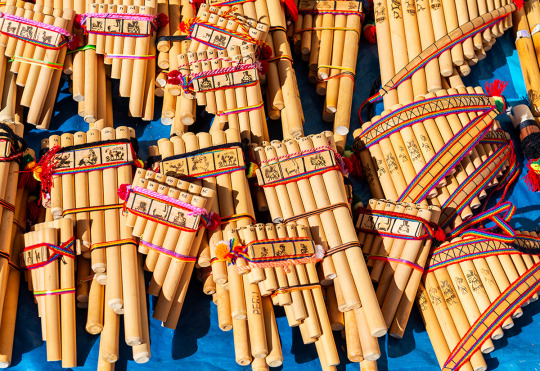

Traditionally considered a 'man's instrument' - Moche was taught by her Uncle Huacan for her to aid in traditional ceremony.
As a Mamacona and Curandera she also knows traditional dance, and loves all other kinds of dancing too.
Moche was the first female flute player to be accepted into her universities Musical Program.
She also plays acoustic guitar (and the first time she saw Hobie swinging his she was like 'What's wrong with you??') and occasionally sings.
And she makes her own music - though it's not what most people expect.
Moche writes mainly Inca-rap and 'Runagae' - a blend of Runasimi (literally 'The people's language') and Reggae.
She's is from 1992 after all.
Runagae takes large influence from Reggae drums and rhythm, mixing it with traditional Andean instruments like flutes and percussion.
Like an indigenous version of Reggaeton and Rap.
Runagae is often in many languages, primarily Quechua, Aymara, and Yucatec - as well a indigenous languages from the Caribbean.
Miguel is a sleeper fan.
Don't ask what they're listening to - cause Miguel is gonna tell you some obscure ass Runagae rapper from Lake Titicaca
That's because Tawantisuyu is extremely multilingual.
Many because of the half dozen indigenous ethnic groups in the country.
Quechua and Aymara are the two primary languages - with Yucatec being a secondary language, and English an 'international' language.
Yucatec is usually taught in the place of what people usually take as Spanish. This is largely because of Tawanti's close ties to the Aztec Nation of Maya to the north.
Most people know in the cities know their local indigenous languages, as well as secondary Yucatec or English.
In fact less than 1% of people in Tawanti speak any kind of Spanish
Without colonization, Spanish lacks much of it's global influence and many people are surprised to hear Miguel speak it.
He gets questions about both parts of his name there.
Many Tawantins say his Spanish accent in Quechua is hard to understand, or 'unique'.
Miguel Quechua is good enough that he can probably get around without much help, but if he has to talk to someone more than five minutes he's gonna need Moche there.
'Excuse me, he said no pickles.'
One thing she loves just as much as music is her motorcycle.
You're not getting to the highlands with a sedan. Sorry. If you wanna make your way out of Cusco and to her village, you're better off with a bike.
And she rides hers from Lima back to Cusco every chance she gets - the ride shortened to only 6 hours.
The only thing-
Miguel looks ridiculous on the back of her bike. He's HUGE. Everytime he gets on the bike dips down.
And she goes "MI, YOU'RE HUGE."
The first time Miguel really thought she was gonna let him drive.
That might've been the first time in her life she's laughed in ANYONE'S face.
And considering their drastic height difference, she was looking UP and laughing in his face.
Though, as a motorcycle owner himself back in Neuva York, they just got Jess to teach them how to ride through portals.
The other Manaconas LOVE it when Miguel rides through on his bike. He gets a lot of squeals.
But not from Moche.
The two of love racing each other, or just riding together, and that's the biggest way they relieve stress. Just riding through the mountains and streets.
Their first kiss happened after a night of riding their cycles in Nueva York.
Moche kissed him (they were sitting next to each other - otherwise he's too tall)
And she immediately was like 'UH I HAVE TO GO. RIGHT NOW. I HAVE TO GO HOME.'
Considering she kissed a guy 8 years older than her AND HER BOSS
And of course Lyla was easedropping on all this.
To shocked to tell her it's alright, Moche takes off back to 802 before he can say anything.
As soon as she gets through the portal, Lyla is like 'OOOOOOHH, you've really done it now!' - 'Don't tell Jess.' - 'I already told Jess.' - 'Lyla, It JUST happened.' - 'She has her notifications on~'
MEANWHILE Lyla is talking to Miguel back at HQ and they're like 'Lyla, Did you se-' - 'I did.' - 'She-' - 'Uh-huh.' - '...' - 'Do you want me to play your 'too-many-emotions' playlist? - '...Yes.'
Miguel was the first to say I love you - story for another time
Prior to appearing on his boat, Moche had barely spoken to Hobie or Diane - though she knew who they were.
She honestly thought the two of them were literally crazy. She understands VERY little of what they do or how they act.
On one hand, Moche needs things to be very blunt, and is more fact minded. That's why her and Miguel get along.
On the other, Hobie is very cryptic and good at concealing things - everything he does having an extra layer of context.
Moche can't read that context AT ALL - and because Hobie isn't being dishonorable, only a weirdo, her power doesn't help.
But that combined with Hobie's accent, Moche can barely follow a conversation with him without saying "Elaborate." ten thousand times.
Or just flat out saying "What are you talking about?" - "Hobie, You're not making any sense." - or - "You're speaking gibberish right now."
His elaborations never help.
There's been many times in the past that Miguel and her have had conversations about his mysterious ways after he leaves the room.
'I swear, I'll never understand him.' - 'I've stopped trying.' - 'I don't think he wants to be understood.' - 'That's usually called being a pain in the ass.'
Though Hobie respects her on the whole 'Indigenous God Vessel' thing - but he's even more interested in Aia Paec.
He LOVES annoying him, knowing that Aia can't directly reply and that Moche is caught in between.
Sometimes though it gets to the point of Aia Paec consuming control to tell him some choice words.
Hobie loves this.
Though it isn't until Moche sees the workshop of his boathouse that her purpose with the team is revealed
Because of her work at The Society, her and Hobie work closely together on things like new watches and other multiverse technology.
After he realized that Moche had lost her best friend in Lyla, Hobie made it his mission to become her friend no matter what
And he finds they really grow through their love of music and composing. You might find it surprising, but Hobie doens't just play music - he KNOWS it
Scales, Majors & Minors, Tempo, the history behind classic composers, blues artists, everything
So even if they don't really listen to the same music, they talk about music like it's a science, how a key change can really give a song emotion, different kinds of singing the singer uses - etc
He's successful - and although they're basically opposites in every way, somehow Moche thinks he's an absolute goofball - plus he helps her get out of her shell more.
He's without a doubt her second best friend - after Lyla (Mayday is her third.)
Hobie completely understands why she may not get his jokes all the time and never looks him in the eye, he's super chill about it.
Eventually the two of them learn how to reactive her watch, and using the old parts, Hobie made Moche a new one with her own separate Lyla, with her old memories and all.
Their reunion was REALLY EMOTIONAL. They're literal bffs4ever.
Tawantins (citizens of Tawanti) don't call Moche Spider-woman
Instead, she's is usually called the AwaqMasi or simply Masi - Quechua for 'Weaver's Assistant'
In this case, Aia Paec is the Weaver - and Moche is considered the assistant.
Because of this, she's usually treated like a public servant - someone spiritual hired to do a job - rather than a 'chosen one'.
This extends to Miguel as well - if his fangs are showing. Which sucks, considering he's fairly clueless in her world.
Often, Tawantins who see his fangs will almost start ordering him around, expecting him to help. Like telling him to take the animals out, though he's never touched a llama in his life and doesn't know the difference from an alpaca.
Good thing his can retract and he can get out of it. Moche is very jealous.
Often for them to get in somewhere, like needing a place to sleep during travel, they'll be lengthy conversation in Quechua with someone before she turns to him and goes "Show the fangs."
Usually, that's enough.
People know Moche and Aia. They're not novel.
But when people see MIGUEL, a huge new fanged being, they treat him like he's a newborn on his first day home.
Moche often has to tell them he's 'empty-headed', as in he lacks a patron God.
Miguel always has to ask if she has to say it that way (she doesn't lol)
[LMAO I had to add a break here so tumblr wouldn't mess up the post formatting]
Now however, Tawantins know about Miguel, and 'Spider-man'.
Although the same way her people don't call her 'Spider-woman', they don't call Miguel 'Spider-man' either. In fact, they don't associate him with spiders at all.
Most Tawantins would identify him as a jaguar - a sacred animal in Andean culture
This is mainly because of the way Miguel's fangs, claws, the way he runs, and his long leaps.
Because of this, the hero 'Spider-man' is called Runa-utu-runcu, though they usually just say Runarun.
A 'Runa' is an indigenous person, and a 'UtuRuncu' is a jaguar - so the same way Moche & Aia are seen as a spirit and a human -
Most Twantins see Miguel as something akin to a werewolf. Or werecat rather.
They believe he is a man who turns into a spiritual 'panther' of sorts.
Which Moche finds hilarious. The head of Spider-Society getting called a cat? Genius.
When Jess told Moche that Gwen called Miguel 'Garfield' - another orange cat - she laughed until she was in tears.
Because of this, Moche will call him 'Runcu' as a way of calling him 'jaguar' - the same way MJ says 'tiger'.
She also calls him Garfield and makes cat jokes about him.
"His webs are red lasers so he can entertain himself like the housecat he is."
Tawanti is a communist nation - much of the culture based on the traditional Incan 'commune-like' village.
Miguel was astonished to find that if they flash people their fangs, they'll just - invite them in. They're happy to have them.
Because of the vibranium-laced gold found near Lima in the 1800's, the country is a large player in world politics and economy.
And citizens can enjoy things like basic income, rent-controlled housing, free university, and more.
Thanks to the vibranium, Lima is very 'Wakanda-like' in essence and New York in everything else.
The average Quechua woman is 5'0", and Moche is just under that at 4'11. Her and Miguel have a 22 inch height difference - almost 2 feet.
This she is fine with. What she ISN'T fine with us people making it out to be a HER thing.
'Awww you look so short next to him-' No, Moche INSISTS, she's average. He's just fucking gigantic.
He barely fits doorways in Tawanti. The village had to weave him new clothes cause nothing they had fit.
With Diane at 5'11" (6'4'' in skates) and Hobie at 6'5", Diane WISHES they had a height gap. And she hates it if you say they're the same height.
(Hobie always tells her they're the same height. No, we're not, She says while being almost exactly at eye level with him)
Meanwhile, Moche and Miguel are the opposite.
They'll look at you like it's bizarre you noticed, because well... It's not that they get anything out of it. Other than maybe neck pain.
It's not like Miguel finds her 'more cute' because she's 'small'. And if anything it's kinda annoying.
Especially when Moche is mad at him - so she makes him sit down during an argument so it's fair.
If you bring it up or say something like "Awww, he makes you look so tiny!'
She's likely to say "I know, he's a freak of nature isn't he?"
Or going further "He makes everyone look tiny. He's 6'9". Back home, you can see him from a block away. People crowd around him. Honestly it's kinda hard taking him in public-"
This is usually enough to get Miguel chuckling, as he loves a good roasting. Though he's the type to burst out laughing and then clear his throat, immediately try to hold it in.
They love roasting each other.
Just the same, Hobie towers over her as well - with an 18 inch height difference.
Moche speaks Spanish with a noticeable accent, and often drops certain parts of sentences on 'accident'.
Quechua doesn't have separate pronouns for genders - however both English and Spanish do. And in addition, Spanish genders objects as well. Which is very confusing for her.
She often leave out 'el' and 'la' in a sentence - but congregations are terrible for her, so she usually just switchs back to English.
However Miguel has spent enough time with her in Lima for her to mash Spanish and Quechua - usually for his sake and not hers.
Because of this, she prefers speaking English on campus.
Most of the time her and Miguel speak English to each other, or more recently, Quechua. But if they'd like their conversation private or are on a team with other Spanish-speaking Spider-people, then they'll use Spanish.
She still hangs with a lot of Latino community on campus, though she can't relate to a lot of cuisine, culture, or slang. And she's very close with all the Indigenous spiders.
When Aia Paec assumes control of Moche, a gold neon-like mask flashes dimmly over her face - in the emblem of Aia's face.
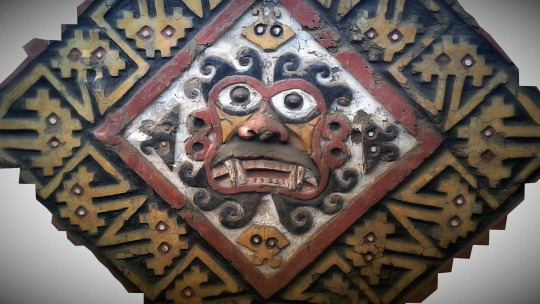
Because of her circumstance and her role as Avatar of The Decapitator, Moche is apart of the small number is Spider-people known to kill. She sees nothing wrong with this and finds it weird if someone does.
Aia's reasoning? He'd been killing long before the first Spider-man came to the first Earth, and he'll keep doing it after if need be.
Aia will immediately braid Moche's hair if it's unbraided and cover her head with a hat or cloth as soon as he gets the chance to - and this is a good indicator of when he's the one more present in the moment.
After work Miguel would often come to her universe, for Moche to teach him Quechua. He's almost conversational at it - thought they can't get through a lesson without the other Mamaconas whispering and giggling.
Her and Miguels favorite part-time though is slow dancing, which they usually talk during. It's relaxing and REALLY funny, considering Moche has to reach ALL THE WAY UP to even touch his shoulder. (4'11" and 6'9" is a sight to see)
They're the couple that always disappears to hang out together. Homebodies basically.
Miguel genuinely draws crowds in Tawanti. He's often a foot and a half taller than everyone - plus he's jacked. Seeing a mountain of a man who can't speak a lick of Quechua following their Protector around always gets stares.
In her country, people will often be outright shocked he speaks Spanish - often approaching him in Yucatec, the second largest language in Tawanti.
Moche's name comes from a culture that predates The Inca Empire - The Moche
Aia Paec (or Ai Apaec), the Fanged Spider-God is the Creator of The Moche people, so I saw it fit that Aia-Paec created my Moche - and IncaSpider as well
Moche - capital of the Moche people - is also a place in Peru to this day, in the province of Trujillo.
Because Andean art is typically related to pottery and textile, her universe is largely unstylized.
AIA PAEC ALMIGHTY WE MADE IT.
If you genuinely read this far THANK YOU SO MUCH. It genuinely does mean a lot to me. For me, I have never seen Quechua culture represented - anywhere. I've never seen a Quechua - or Incan - or Peruvian hero, so why not make one!
I hope I was able to share some of that culture with you and you found any of it interesting or new.
In this post I mentioned Huachuma Cactus (and Ayahuasca) and their ceremonial uses - and below is more information I'd like to offer for those curious. If not, no sweat!
THANK YOU SO MUCH AGAIN and as a Quechua-decedent and a follower of indigenous religion - I will always try my best to answer any questions.
Here's a picture of Miguel. You can imagine Moche standing in front of him - in this photo you would be able to see her anyway lol. (I checked)
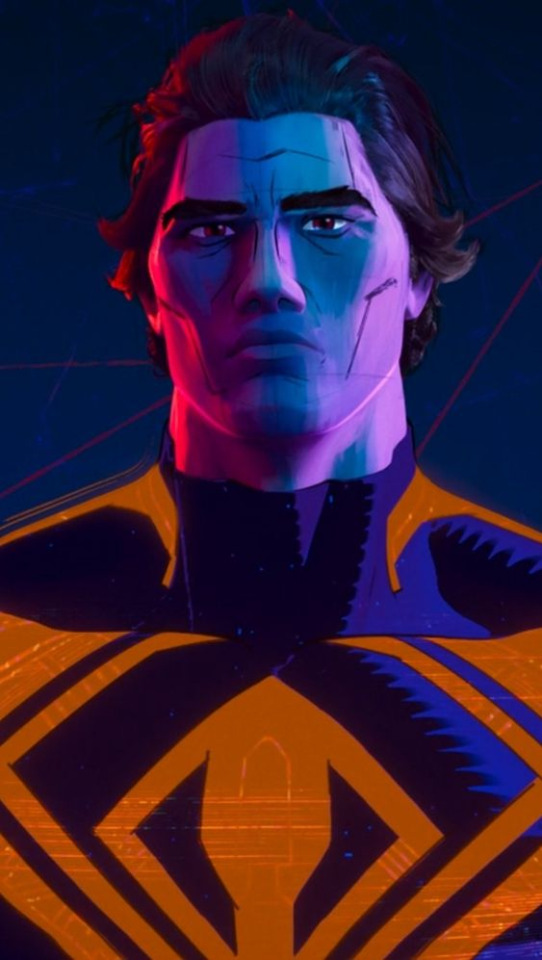

Bye.
NOW LET'S GET INTO THE NERDY STUFF -
___________________________________
[ I am a Quechua decent as well as a follower of these practices. I personally have gone through ceremonies with plant medicines in the past and hope to dispel some misconceptions ]
DISCLAIMER: Huachuma and Ayahuasca are NOT closed practices - anyone can sit in ceremony regardless of religion or ancestry - as long as they are siting with the intention of spiritual growth or self help. And even today these plants are used in treatment of addiction, abuse, and mental illness.
These plants are NOT drugs. They are medicines are should be treated as such. Trust me. Huachuma and Ayahuasca trips aren't fun and they aren't supposed to be. They are made for healing.
ALSO - I am a practitioner of Andean Spirituality and Ancestor Worship. Although Aia Paec isn't apart of my practice - everything stated below IS. Please treat it with kindness, and do not call it things like a myth or cult or something.
These are sacred practices we are hoping to share with the world to promote mental healing. Please be respectful (ya'll always are) and thank you so much.
Huachuma Cactus / Ayahuasca & Plant Medicine:
[Hwa-Chew-Ma / Eye-ya-hwa-sca]
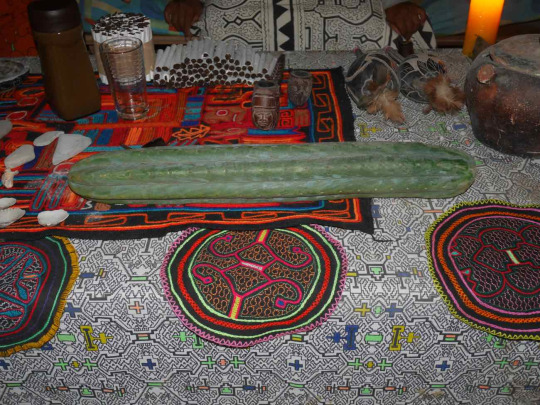

[Raw Huachuma Cactus and Ayahuasca Root]
Often called San Pedro Cactus - after the Spanish Saint - Huachuma Cactus is a vital part of Andean spirituality.
Huachuma & Ayahuasca are two of the most revered plant medicines - known for inducing extended psychedelic trips. However, these trips are not similar to LSD or Acid.
Used for literal centuries Huachuma Cactus & Ayahuasca Vine have been taken (separately or consecutively) through a bitter brew of medicinal plants.
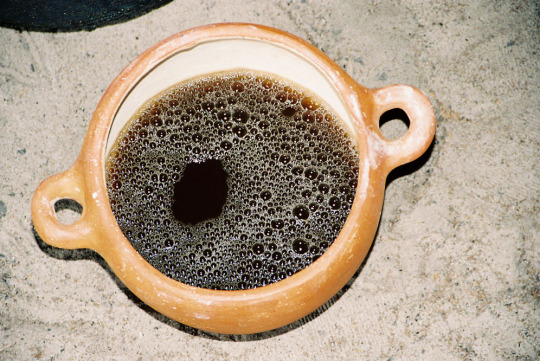
[Ayahuasca above. Shit tastes GNARLY. Ayahuasca like coffee and licorice - Huachuma like Nickelodeon Slime. Huachuma is thicker and green.]
Huachuma & Ayahusaca is usually reserved for those within the practice - or those facing deep trauma, mental illness, or something to internally heal from. Huachuma and Ayahusaca are specifically used to bring buried emotions and memories to the surface - as well as a feeling of euphoric self-compassion - in a safe and sacred space in order to help the person grow mentally.
Huachuma & Ayahusaca trips are not pretty - and often involve sobbing, vomiting, and painful memories. Diarrhea too. These trips are not meant to be recreational, but psychological treatment.
These ceremonies require a large group of Curanderos - indigenous healers as well as trained mental health professionals. Many Plant Medicine ceremonies have a trained therapist or psychologist throughout the stay - and a long integration process to reflect and heal.
And while this might sound out there, recent science is showing the profound effects of Plant Medicine - and that Ayahuasca directly impacts many parts of the brain extremely positively.
Now, scientists have gleaned deep insights of their own by monitoring the brain on DMT, or dimethyltryptamine, the psychedelic compound found in Psychotria viridis, the flowering shrub that is mashed up and boiled in the Amazonian drink, ayahuasca. The recordings reveal a profound impact across the brain, particularly in areas that are highly evolved in humans and instrumental in planning, language, memory, complex decision-making and imagination. The regions from which we conjure reality become hyperconnected, with communication more chaotic, fluid and flexible.
[Source: The Guardian - also as for the first line in the article, people DO NOT have near-death experiences while in proper Ayahuasca ceremony - just listen to the medical stuff cause wtf]
Spirits & Plant Medicine:

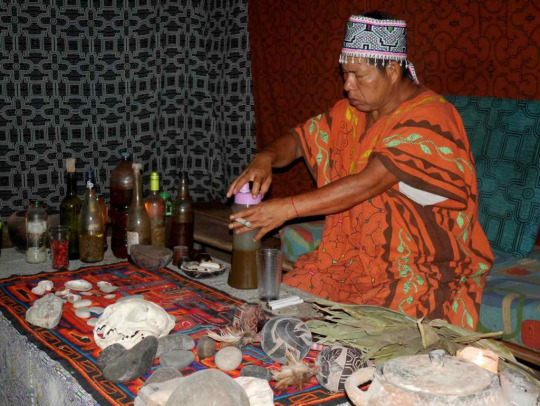
[Left: Raw Huachuma Cactus - Right: A Curandero setting the Mesa (the red tablecloth in this case). You can see the jar of Huachuma (or Ayahuasca it looks like Aya in this case) in his right hand, as well as a cigarette. The smoke is blown into the brew to kinda 'wake up the spirits'. Being from the Andes - tobacco and coca leaves are traditionally used in ceremony a lot.
The table is covered with other offerings to the gods, stones to represent mountain spirits, and a number of other things used in the ceremony.]
I cannot stress this enough - In Andean practice, we believe each plant has a particular spirit associated with it. Like a fully-formed deity. And ceremony is often approached as if you were meeting someone you respected.
Often in ceremony, people may see and speak directly to these spirits. (Which is true in my experience but not everyone.)
Because Huachuma and Ayahuasca often go hand-in-hand, they are often referred to as the Grandfather (Huachuma) and the Grandmother (Ayahuasca - also called Mama Aya for short).
And we genuinely believe that the way you approach ceremony, your intentions, and your willingness to heal directly affects the way the Spirit will treat you or deal with you, but it is never in a malicious way.
The Grandfather - Huachuma is considered tamer, more milder - one of the reasons I chose Huachuma instead of Ayahuasca in this case.
Huachuma is centered on personal peace and emotion. While on it, your emotions are amplified, you feel a deeper connection to the Earth. But you also throw up too usually. The drink is grosss. (Sorry Grandpa)
Trips last 6-8 hours, but affects can linger for 14-18. Unlike Aya, Huachuma induces less visuals or 'trippiness', but a state of thoughtfulness - bordering joyful meditation. (As these do have neurological connections to the effects of long-term meditation.)
Huachuma can be consumed raw, or served as a drink. [I believe I was given a mixture of raw cactus, agave, and water. You're told to CHUG IT because it thickens a lot in like a minute and gets gross.]
That's largely why I chose Huachuma for Moche to experience first instead of Ayahuasca.
The Grandmother or Maya Aya is much more forthcoming and intense, and her work is centered more of personal healing and self reflection - and Ayahuasca is more akin to a 'trip'.
Typically, a trip lasts 8-12 hours and is taken overnight and sundown. Trips include things such as psychedelic visuals, flashbacks (and yeah, if I'm being honest, everyone I have sat in ceremony with regardless of religion reported a feeling of being close with the Source, God, family whathaveyou. So, the sensation of being elsewhere. In a way. I experienced this too and the feeling is very vivid. Of course what you experience is very personal to you.
While on Ayahuasca you may experience nausea, and the visuals, memories, and emotions make it useless to really move around. You're a lot more in it than Huachuma. Essentially you take it, you set your intentions, you sit in the dark, and let Mama Aya 'work on you'.
Which is why I chose to put Miguel through an Ayahuasca ceremony at their meeting. [Mwah haha Miguel You WILL heal]
Ayahuasca vine cannot be consumed raw, and is a lengthy brewing process with a number of plants known to Curanderos.
Plant Medicine & Ancestors:
Both plants are also associated by many with Ancestral (or divine) contact, and/or visuals of past lives. Which is what drove the inspiration to have Moche partake in a ceremony.
MY EXPERIENCE: - in short - just incase someone is curious -
I've personally sat in official ceremony three times, in which I meet with Mama Aya twice, before meeting the Grandfather the day after. (Basically I drank Ayahuasca for two night and Huachuma on the third day as apart of the integration process.)
The traditions were done in a ceremonial space with a Curandera & Curandero of Peruvian tradition - as well as multiple mental health professionals.
Preparation for ceremony often takes days or weeks - and one is expected to focus on mindfulness and self-kindness all that days leading up to it. (As much as possible, as many Non-Andeans who go into ceremony usually do so for addiction, depression, mental illness, or a number of things).
In my ceremonies - The ceremony and the people I connected with there are pivotal to my path and life so far. Despite meeting people from literally anywhere, it was also one of the most trans-affirming spaces I have ever been in - which is saying a lot as a New Yorker.
Each ceremony was hard, with the second night of Ayahuasca being the most emotionally and visually intense. This was amplified be the ceremonial music. Thankfully, however I didn't get too much physical side effects. I don't even think I barfed the second night. Big win!
In all Ayahuasca helped me have a way deeper understanding of myself and my wants and it helped me gain closure on a situation I'd been struggling with for years.
My experience with Huachuma was more milder and calmer, although my emotions were hyper-sensitive as were my senses - which is why it's VERY important to do ceremony in a container (a safe space with professionals on stand-by)
The Huachuma ceremony was conducted outside during the day. Because you are more lucid and emotionally calm while under Huachuma, it was encouraged for us to be present in nature and move and walk around.
In all Huachuma helped me to focus more on compassion and was able to form deep bonds with the people around me in a shorter time. I was more present and rather than psychedelic visions, my surroundings were more vibrant and intense but in a comfortable way.
Overall, Ayahuasca and Huachuma are deeply sacred, deeply interesting plant medicines that have shaped Andean spirituality for centuries.
They are not typical 'drugs'. They are medicines and should be treated as such. (aka As prescribed, while under the watch of someone trained and understanding.)
So uhhhh yeah. That's a lot that's a lot lol
But if you made it this far THANK YOU SO SO MUCH FOR YOUR TIME and giving me a chance to share this culture with others!! 💚
I hope you learned something from this little section here, as I genuinely hold the Grandparents dear and found my ceremonies exceptionally healing.
If you have any questions, let me know! Oh and if you really made it this far - uhhhhhhh QUESTION:
You can choose TWO people from ATSV to protect you - everyone else will try to jump you. Who you picking?
{I just wanna know if anyone got down here also the question is funny as hell - I'm picking Hobie and Miguel. But....they would bicker and probably get me killed. Oops. Maybe Hobie and Pavitr. Pavi has GREAT luck. So far. }
Bye.
#FUCCVKK I'M SO HAPPY TO BE DONE WITH THIS POST#Mild Miguel with a side of asexuality#spidersona#spidersonas#spiderman#atsv#across the spiderverse#across the spider verse#miguel o'hara#miguel ohara#miguel x oc#miguel o'hara x oc#miguel ohara x oc#Lyla#atsv lyla#Hobie Brown#pavitr prabhakar#jessica drew#jess drew#spider verse#spiderpunk#spider punk#spider man#spiderman india#marvel#Moche#IncaSpider#Inca Spider#spiderman oc#oc x canon
259 notes
·
View notes
Text
Unos meses más tarde, Killa volvió a tener pesadillas con visiones de su pasado.
Una noche, soñó con una mujer.
Luego, al despertar, comenzó a murmurar:
"Mamacona sunqu chay, mamacona munanchay, mamacona sumaq"
Rain volvía a si casa luego de una fiesta y la escuchó murmurar:

"Mamacona sunqu chay, mamacona munanchay, mamacona sumaq"
Rain se acercó con sumo cuidado:
"Killa...que sucede...?"
Ella se acercó a un pequeño teclado y tocó la canción más bella que Rain jamás había escuchado.

0 notes
Text
Lima: More than a Capital City
When travelers choose Peru as their next destination, the majority of them plan their visit to get to Machu Picchu as soon as possible, and end-up missing the many varied cultural and recreational activities that Peru has to offer. A common comment from visitors is that if they had known more about Peru, they would have planned their trip differently; therefore, if you are planning a visit, you should carefully research all possible options to get the most out of your vacation in Peru.
An example of this is the region of Lima. Many travelers think that Lima, the capital city, is just another overpopulated capital with not much to offer. Although Lima is a heavily populated metropolis, most of its population comes from the other 23 regions of Peru, thus making it a multicultural capital where all the diverse customs and practices of Peruvians converge to offer a great experience to travelers.
Thus, Lima is history, culture, food, and a coast with beautiful beaches. The history of the region of Lima started with the people of Caral about 5,000 years ago. Caral was discovered in 1997 by the Peruvian archaeologist Ruth Shady, and as of today it is the oldest civilization of the Americas. It is believed that their sociopolitical organization served as inspiration for the rest of civilizations which arose in the central Andes of Peru. The remains of this interesting archaeological site are located in the Supe Valley, two and a half hours away from downtown Lima. Before the arrival of the Spanish conquerors, the city of Lima was chosen to be an important administrative site by the Lima, Wari, and Inca civilizations as proven by the remains of archaeological sites such as Huaca Pucllana, Cajamarquilla, and Pachacamac, respectively. The artifacts and remains of these and other Peruvian civilizations are on display in the city’s many museums.
Several shows in the city allow travelers to experience and learn about Peru’s various customs. For instance, La Dama Juana Restaurant offers a buffet dinner show, where dancers perform some of the most popular genres of the coast, the Andes, and the rainforest. The show is well executed and provides a unique experience where travelers can observe the syncretism of Spanish and native Peruvian customs. The Spanish conquerors also introduced horses to Peru. The horses brought to Peru adapted to their new environment, eventually creating a new breed. These horses, known by their four-beat lateral gait, can be enjoyed every Sunday at “La Hacienda Mamacona,” where a buffet-style lunch is also served.
For food lovers, Peru can be a paradise. In the last 15 years, Peru has become a popular culinary destination, and Peruvian restaurants all around the globe are recognized and prized by the most well-known and popular food magazines and critics. This fame has been gained thanks to its unique native products, the cooking techniques developed over a long period of time by native Peruvians, and the culinary practices brought to Peru by waves of various immigrants, such as the Spaniards, Africans, Chinese, Italians, Japanese, among others. All this diversity can be fully enjoyed in the city of Lima, where the most recognized restaurants of Peru are located. Lima offers restaurants with food options for all tastes and incomes, and travelers won’t be disappointed with any of them. Some restaurants such as “Central,” “Maido,” “Osaka,” “Astrid y Gastón,” and “ámaZ” require reservations made well in advance.
The city of Lima has a totally different feel depending upon when it is visited. From mid-November to April Lima enjoys a lot of sunshine as well as spectacular sunsets. The rest of the year is generally overcast. Going for a walk or a bike ride in the boulevard that connects the districts of San Isidro, Miraflores, and Barranco is a singular experience, but embarking on any of these activities during the summer is a truly incredible one. Also, enjoying a Ceviche with a beer or a Pisco Sour with the view of the Pacific Ocean during a sunny day is just a total pleasure.
youtube
By Renato Romero - Founder of My Peru Guide LLC
2 notes
·
View notes
Text
🔵 #Nacional LIMA: LO CLAUSURARON
Los fiscalizadores de la municipalidad de Lurín, clausuraron el local donde el futbolista Paolo Guerrero armó tremenda fiesta por su cumpleaños número 38. Al Fundo Mamacona acudieron cientos de invitados y varias orquestas musicales, pese a las restricciones por la COVID-19 y la variante ómicron....

0 notes
Photo

Por aquí ando, después de muchos años .!!!! (en Fundo Mamacona) https://www.instagram.com/p/CSC9JFdFQh5wCwLeNVz88kXT9liT_Cdsr6Xx4Y0/?utm_medium=tumblr
0 notes
Text
Inca Sun worship
“They visualised the Sun in their imagination as if it were a man, and consequently they said that the Moon was his wife and the stars where the daughters of them both.
The Sun was so venerated throughout this entire Inca Empire that I doubt that there has ever been any place where idolatry was so widespread, respected, and served. This is clearly illustrated by the fact that there was no other god to whom so many and such magnificent temples were dedicated. There was no major town that did not have a Sun temple with ample service of priests and mamaconas and a large income to sustain them. Above all, the Sun temple was always the most sumptuous. And the most magnificent temple of all was the one called Coricancha that the Incas had built at their court . . . The Indians said that along withs its light the sun transmitted its power.”
— Father Bernabe Cobo, Inca Religion and Customs
* * *

Inca celebration of the Sun
#Incas#The Ancient Americas#Sun worship#Spiritual Sun#Art#Beauty#Illustration#Father Bernabe Cobo#Inca Religion and Customs
20 notes
·
View notes
Text
Pachacámac (zona arqueológica)
A las nueve de la mañana, después de desayunar, ya estaba dispuesto en la plaza Grau a la espera del autobús con dirección al distrito de Lurín, situado a 30 km. al sur del cercado de Lima.
El recorrido me descubriría una Lima muy diferente. Traspasando el barrio de Surquillo la basura se comenzó a acumular en cualquier rincón, las viviendas lucían oxidados techos de chapa, y el adobe competía con el tocho visto. En villa el Salvador en las desérticas colinas paralelas a la panamericana competían las chabolas con las zonas de cultivo, preguntándome de dónde surgiría el agua para nutrir vegetales y personas.
Pachacámac es una zona arqueológica ubicada la margen derecho del río Lurín, muy cerca del océano Pacífico y frente a un grupo de islas homónimas. Se halla en el distrito de Lurín, en la provincia de Lima. El viaje dura una hora y tenéis que bajaros antes de llegar a la villa, delante de la zona arqueológica bien señalizada, si os pasáis tendréis que recorrer los cuatro kilómetros que las separan. Contiene los restos de diversos edificios que datan desde el siglo lll (intermedio Temprano) hasta el siglo XV (Horizonte Tardío). Aquí se veneró durante 1200 años a Pachacamac, creador del universo y de todo lo que contiene, Dios del trueno y proveedor del agua y el fuego. También se hallaba un antiguo oráculo al que acudieron pueblos desde Ecuador al norte de Chile.
Antes de incorporaros a la zona arqueológica propiamente dicha, os recomiendo que paséis primero por el museo (tenéis que dejar el bolso o mochila en recepción) y se permite fotografiar. Después aseguraros de llevar agua, protector solar, un gorro y disposición a caminar, ya que el circuito tiene más de cuatro Kilómetros. A mitad de camino me di cuenta que yo era de los pocos que lo hacía caminando, ya que según parece se pueden alquilar coches que te llevan, parando en cada una de las construcciones, también observé coches que supuse de circuitos privados, incluso un minibús. Creo que en grupo debe valer la pena, ya que realmente es muy cansado bajo un sol abrasador, pisando arena y con ascensiones potentes.
Voy a intentar conjugar el análisis histórico con la observación de las construcciones, aunque el recorrido no sigue exactamente el desarrollo histórico, por otra, aunque bien documentado en grandes paneles vuelve a necesitar gran dosis de imaginación para percibir las formas originarias. Ninguna de las construcciones se puede visitar su interior, tan solo la del Sol se puede dar una vuelta por su contorno en un segundo nivel.
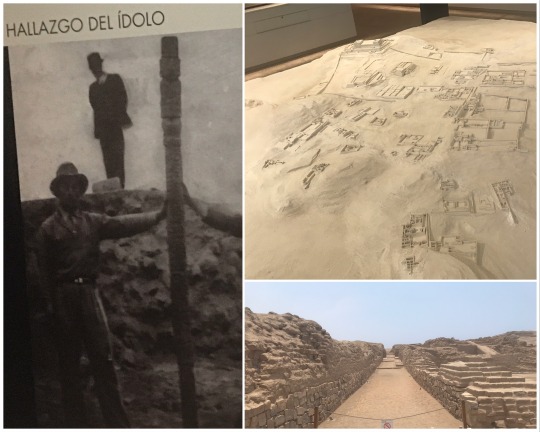
La ocupación de la zona comienza en el 200 a.C., dado que se ha encontrado un cementerio de esta época, se dedicaban a la pesca y a la agricultura. Su cerámica, denominada estilo El Panel, la conforman básicamente botellas en forma de aves y felinos; también confeccionaban objetos de cobre.
Del 200 al 600 d.C. se desarrolla la cultura Lima (de la que hablé, al igual que de su técnica de construcción del “librero” con adobitos en la Huaca de Pucllana en Miraflores, la única que he podido ascender y que realmente se agradece). Los Lima inician la construcción del santuario con el “Templo viejo”, convirtiéndose Pachacámac en el principal centro administrativo del valle de Lurín. Éste templo primigenio está totalmente destruido y tan solo se pueden ver los restos de sus muros con su característicos adobitos.

A partir del 600 al 1100 d. C. se establece el imperio Wari, siendo con ellos que se desarrolla el apogeo del oráculo de Pachacámac, convirtiéndose el “templo de Pachacamac o templo pintado” en el principal centro religioso y de peregrinación panandino.
El llamado Templo Pintado, conocido como Templo de Pachacamac, es una pirámide escalonada de unos 100 m de largo por unos 50 m de ancho. Al igual que otros edificios su base es de piedra y sus estructuras superiores de adobe, enlucidos todo con una capa fina de barro. Se llega a su cima por un camino en zigzag que asciende por medio de largas rampas, en donde hay dos patios grandes. En tres de sus lados se distinguen nueve terrazas o más bien escalones, algo curvos y de casi un metro de altura. Estas terrazas tenían originalmente sus paredes pintadas en rojo y algunos de sus sectores presentaban figuras multicolores que representaban personas, peces, animales marinos y plantas en rosado, amarillo y azul estas pinturas, descubiertas en 1930 se degradaron con facilidad, en la actualidad hay un desesperado intento de recuperación, al menos para que las del frontis no ocurra lo mismo.
De esta época data un extenso cementerio, excavado por Max Uhle en 1896, que se encuentra al pie y por debajo del Templo de Pachacámac, así como una serie de ofrendas de cerámica halladas en la zona. Uhle creyó apreciar en las cerámicas, textiles y otros artefactos desenterrados, iconografías propias de Tiahuanaco (cultura del altiplano), que hoy sabemos se trata del estilo de la cultura huari, pero que en su momento llegó a teorizar sobre la existencia de un imperio tiahuanacota.
Hacia 1100 d.C., los Ychma establecieron su centro de poder y administrativo en Pachacamac, con una serie de asentamientos alrededor del Río Lurin. De esta época son unos 16 edificios con rampas de acceso, que los arqueólogos han denominado Templos con Rampa o las Nunciaturas, Uhle los denominó palacios. De ellos se observan dos, el resto están totalmente en ruinas. La base de cada una está hecha de piedras canteadas y el resto es de adobe; sus paredes estaban enlucidas.Cuando llegaron los españoles se encontraban en ruinas. El nombre de «nunciatura», se refiere a que eran sedes de las diversas naciones del mundo andino que rendían culto a Pachamac. Eran construcciones con un gran patio delantero y al volumen piramidal se accedía por medio de rampas. Arriba se abre un espacio en forma de herraje con una serie de pequeños ambientes. Detrás existen grandes depósitos para alimentos. La hipótesis tiene bastante retractores, ya que la modificación de escaleras por rampas devino al llevar a los “señores o gobernantes” en andas, nunca a los cónsules o delegados. Aunque cabe la posibilidad de que se hicieran para la visita eventual de éstos, en todo caso, cabe preguntarse dónde estaba el palacio del gobernante de los Icsma y si probablemente siguieron utilizando el Templo pintado como huaca principal de adoración, incluso si las rampas y otras estructuras de este templo fueron aportadas por ellos.
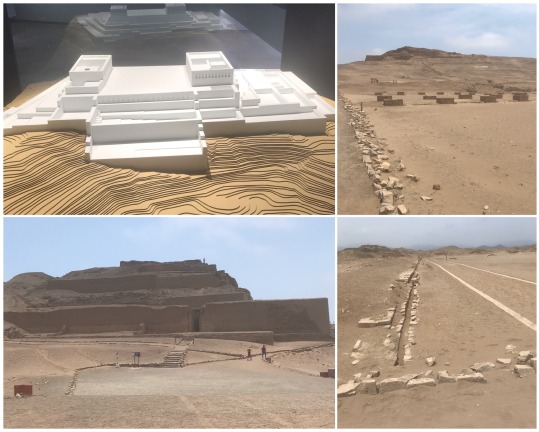
En 1470 los Incas establecieron aquí una importante capital provincial y uno de los principales centros administrativo de la costa, de ellos son las mejores edificaciones conservadas.
El templo del Sol es la pirámide trunca más grande y mejor conservada del conjunto. Se levanta sobre un promontorio rocoso, alcanzó los 40 metros de altura, con cinco plataformas o niveles, desde allí se domina todo el conjunto y toda la costa. Sus bases están constituidas mayormente por muros de piedra canteada y los muros de adobe unidos con argamasa de barro. Tanto las piedras como los adobes estaban enlucidos con capas de tierra fina, con evidencias de haber estado pintado en toda su extensión con color escarlata o bermellón intenso. En la parte que da al mar se distinguen una fila de hornacinas trapezoidales.
Este templo fue saqueado por los españoles, comandados por Hernando Pizarro. Se dice que subieron a la cima de la pirámide, donde se guardaba dentro de una bóveda pequeña, el ídolo del dios Pachacámac, tallado en madera, el cual fue sacado y quemado. El suceso conmovió a los nativos, quienes temieron una catástrofe, sin percatarse que la desgracia era precisamente la llegada de los españoles. En realidad esto se contradice con el hallazgo del ídolo de madera, aunque también hace pensar que los incas tuvieran uno de propio, siendo éste el destruido por los españoles.
Ya expliqué que el ancestral culto a Pachacámac se sincretizó con la veneración al Señor de los Milagros en Lima, llamado también Cristo de Pachacamilla o el señor de los temblores en Cuzco. Os dejo en una fotografía la leyenda de Cavillaca, que explica la formación de las islas.
Bajando del templo del Sol está la Plaza de los Peregrino, un gran espacio rectangular nivelado que contaba con murallas e incluía Incluía el trono (ushnu). Se observa también los fundamentos de una doble hilera de columna que se presume sostenían un techo de totora. Se observa una tercera hilera de columnas en dirección al Templo del Sol.
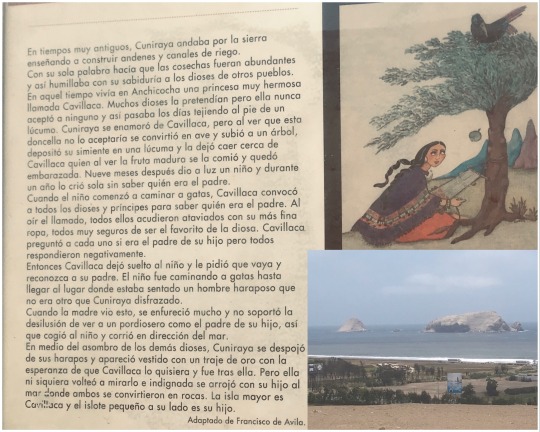
Templo de la Luna (según Max Uhle) o Mamaconas (según Julio C. Tello). La única construcción restaurada y que se agradece, la belleza de los edificios incas me fascina. Inicialmente comenzó la restauración el economista y maestro Alberto Giesecke en 1938, luego por J.Tello en 1940. Los daños serios que se notan en su estructura fueron causados por el terremoto de 1940 y por otros temblores posteriores. Prejuzgando que la restauración obvió algunos detalles antisísmicos de los maestros constructores incas. Esta casa de las acllas o residencia de las mujeres escogidas, según J.Tello, se sitúa en la parte baja del área (final o principio del recorrido). Presenta graderías, patios, sitios ceremoniales, reservorios de agua, depósitos e innumerables habitaciones. Es este edificio se distingue más claramente la impronta inca: hornacinas, puertas trapezoidales de doble jamba y las pulidas y labradas piedras de sus muros. Una preciosidad.

Otra de las estructuras incas es el Palacio de Tauri Chumpi, asentado sobre un promontorio rocoso, hacia el norte, es la considerada como la residencia de Tauri Chumpi o Taurichumbi, el curaca o gobernador incaico que recibió a Hernando Pizarro.
Tello también descubrió el sistema de acueductos y cisternas que recogían el agua de los estratos acuíferos del subsuelo, uno de los cuales es aún visible al sur del Acllahuasi. También se pude visitar el huerto que presenta las diferentes plantas que se cultivaban en la zona.
Una de las notas interesantes del museo es la explicación gráfica del sistema de contabilidad de los quipus.
0 notes
Photo

Ñami. 😋 (en Mamacona, Lima, Peru) https://www.instagram.com/p/B5iHaOkgrVqHshMl4iGQgsdjuvgM9xuY-j6-Sw0/?igshid=kb36v6uyqn1e
0 notes
Photo

Matrimonio 14-04-18 #SeiferDj #LiveMix #AbrilEventos (en Fundo Mamacona) https://www.instagram.com/p/BhkGS7tBXgT/?utm_source=ig_tumblr_share&igshid=vfchd91idtl8
0 notes
Text
Buying a Horse of a Similar Shade: Europe

I put the latest issue of Peak Income together from, of all places, Mamacona, Peru, a seaside town on the outskirts of Lima, where earlier this month I attended the annual Concurso Nacional, or national horse show.
For aficionados of the Peruvian Paso, the country’s signature breed, the show marks the single most important week of the year, outranking even Christmas and New Year’s Day. If you argue to the contrary with a Peruvian cowboy, you’re likely to get horsewhipped.
I’m the first to admit I’m not a true “aficionado.” To have afición is more than simply being a “fan,” as the Spanish-to-English translation suggests. The word additionally implies deep knowledge, expertise, and instinct.
Though I make the effort, I have none of the above. At all.
Despite growing up in Texas, I can barely distinguish a horse from a mule. But my wife’s family – who have bred Peruvian Pasos competitively for three generations – have afición in spades, and I brought my wife and kids to Peru to root for my father-in-law and brother-in-law in the competition.
My beat is income investing, not show horses. But you’d be surprised how the two can overlap.
A good, prize-winning horse isn’t that different from a stock.
Sure, you can try your luck “flipping” a horse, buying it low and selling it high to another aficionado. Or, you can turn it into an income vehicle and hold on to it for a while, collecting “dividends” along the way via stud fees.
As a case in point, my wife’s grandfather died young, in his 50s. But the stud fees generated from his champion of champions stallion supported his widow in retirement for years.
That horse would likely still be paying her retirement bills but for the fact that horses, unlike dividend-paying blue chips, don’t live forever.
Playing with the numbers a little, a $250,000 prize-winning stallion could generate something in the ballpark of $10,000 to $20,000 in annual stud fees depending on how aggressively you wanted to breed him. That works out to a “yield” of 4% to 8%.
I’m not suggesting you run out and buy a show horse to fund your retirement needs. That would be utterly absurd. And I can’t imagine it would end well for you.
Apart from the initial cash outlay to buy the horse, you’d need infrastructure (like a stable to put him in) and a small army of personnel to care for and feed him.
If the cash expenses didn’t bleed you dry, the headache of dealing with the logistics would likely drive you mad.
I prefer income investments that sit quietly in my brokerage account and don’t require food, water, and veterinary expenses.
These are the kind that I recommend in my income-based newsletter, Peak Income.
Last month I made the case for diversifying globally. And – to subscribers earlier this month – I extended the argument, recommending a fund featuring healthy allocations to the major European exchanges and broad sector diversification. I expect it to generate double-digit returns during our holding period.
While I still see upside in U.S. stocks, momentum has clearly shifted overseas. Just take a look at the year-to-date returns of our major trading partners in Europe and of emerging markets collectively.

French, emerging-market and German stocks are all up over 17%. Even the U.K. – which faces two years of bitter Brexit negotiations and a very uncertain future – is modestly outperforming this year.
There are a couple reasons why American stocks are lagging. The first is the effect of currency moves. The U.S. dollar has been weak this year, and assets denominated in foreign currencies have better returns when translated into dollars.
But there’s an even bigger reason, one that I detail in this month’s issue, where we’re buying Europe on the cheap.
If you’ll allow me a baseball analogy, the bull market in American stocks is probably somewhere around the seventh-inning stretch, whereas we’re barely past the ceremonial first pitch in most of the rest of the world.
Don’t get me wrong, there’s a lot to be concerned about in Europe long term: demographic problems, the refugee crisis, the persistent threat of terrorism, and, maybe worst of all, the euro currency itself. It might be the worst idea in a long history of bad ideas to come out of the Continent.
But today, with Europe’s cheaper valuations and its stronger momentum, it makes all the sense in the world to buy European stocks with a relatively short time horizon… and to get paid handsomely while doing it.
Don’t believe me? My overseas recommendation from last month is already up about 4%, and that’s with a low-risk approach, as we seek to do in Peak Income. So you can rely on steady streams of income, whether you’re in retirement, close to it, or just thinking about it.
Click here to learn how to subscribe.
If you’ve missed this month’s issue, click here to read it now.
Charles Sizemore Portfolio Manager, Boom & Bust Investor
Read much more from Charles Sizemore and the rest of the Dent Research team, here at Economy & Markets!
1 note
·
View note
Photo

I found in the parks the answers to office problems. #nature #naturephotography #bluesky #sky #goldensky #tree #park #sun #sunset #clouds #lima #peru #nofilter (en Hacienda Mamacona, Lima, Perú) https://www.instagram.com/p/BpQXAJIlydh/?utm_source=ig_tumblr_share&igshid=i3z1xfxv3730
0 notes
Text
LA CREMA Y NATA CORTADA EN LA BODA DE CECILIA CHACÓN. Ayer por la tarde, en el pituco fundo Mamacona, se celebró la boda del año. La congresista Cecilia Chacón, con una sentencia anulada (porque no fue absuelta) por... https://www.facebook.com/retevision/posts/1708991025804070 …
LA CREMA Y NATA CORTADA EN LA BODA DE CECILIA CHACÓN. Ayer por la tarde, en el pituco fundo Mamacona, se celebró la boda del año. La congresista Cecilia Chacón, con una sentencia anulada (porque no fue absuelta) por... https://www.facebook.com/retevision/posts/1708991025804070 …
from Twitter Search / rtvinfoguia https://twitter.com/rtvinfoguia/status/1000869314424201216 via IFTTT
0 notes
Photo

Hoy por primera vez en mi vida he bailado #yunza con una energía increíble ❤ (at Fundo Mamacona)
0 notes





